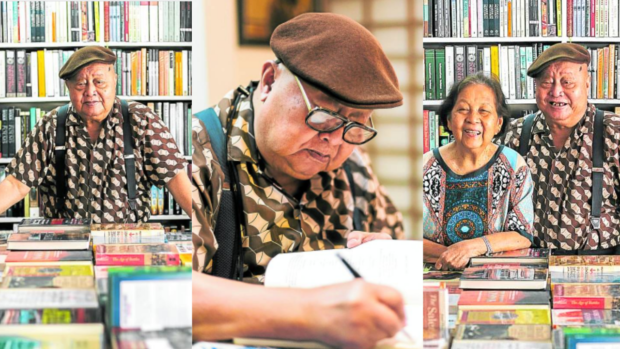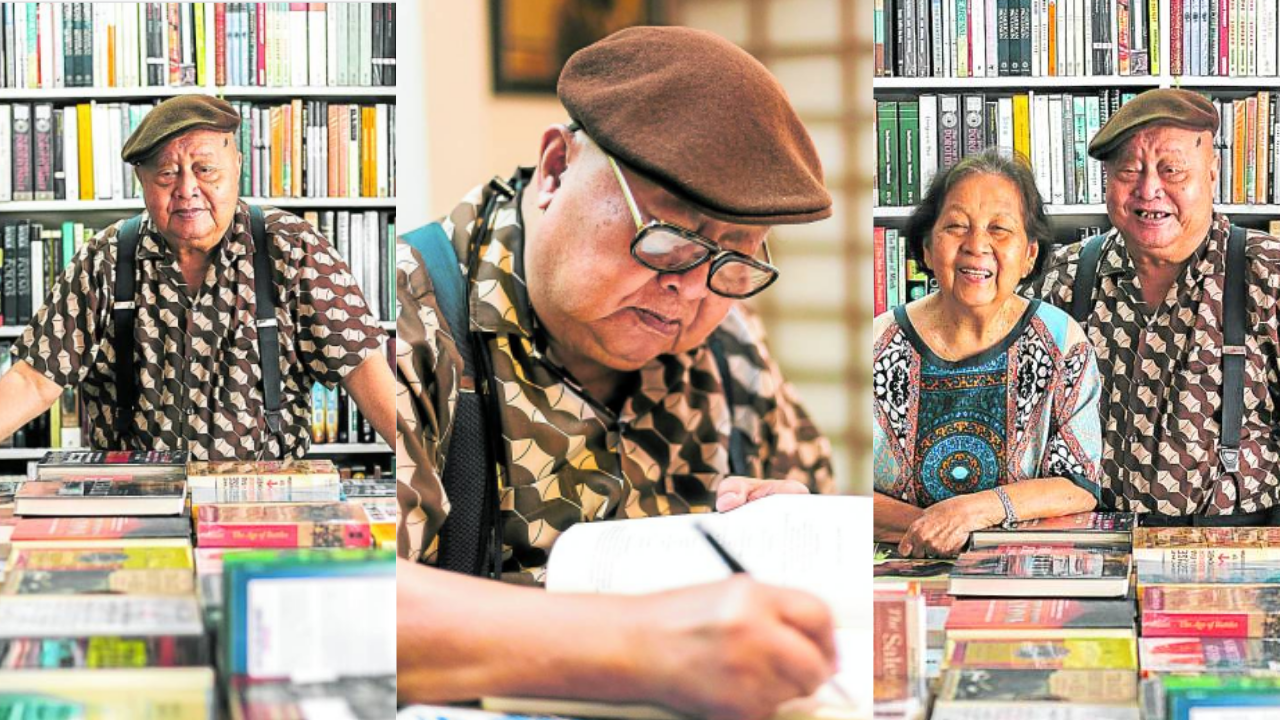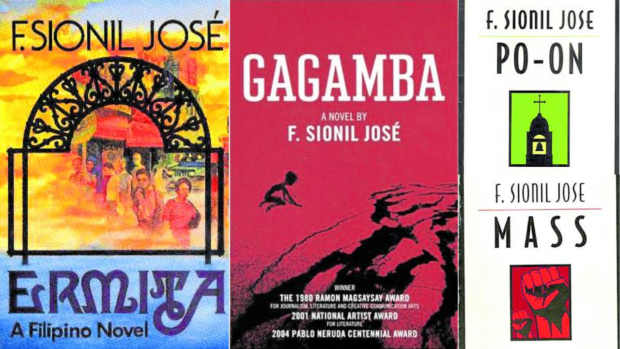
Francisco Sionil José’s had always been a robust, stalwart and kinetic presence, such that when the literary world learned he would undergo angioplasty at 97, despite genuine anxiety expressed about his surgery at such an advanced age, there was cautious optimism he would pull through.
“He is a tough one,” said writer and teacher Cristina Pantoja Hidalgo. “He’ll make it.”
But Frankie didn’t even make it to the operation on Jan. 7. On the eve of his surgery, at around 9:30 p.m., he died in his sleep. As far as I know Frankie hardly read Shakespeare, but his death proved the Bard correct: “Thy best of rest is sleep …”
There had been warning signs. Tessie Jovellanos José, the woman behind the man, had said she didn’t agree with the operation since she feared he was too old for it. She should know, since she took up preparatory medicine at the University of Santo Tomas (UST) but didn’t finish because they fell in love and married. It was Tessie who had made sure that Frankie stayed fit and healthy in his advanced years.
One time at the famous second floor of Solidaridad Bookshop, the Parnassus of Philippine letters, if there was one, after a book launch and reception, we saw Frankie collapse before our very eyes: Good thing his nephew was quick enough to hold him and prevent his head from hitting the floor.
Tessie heard the commotion from the mezzanine and came up. When we told her perhaps an ambulance should be called, she calmly waved our suggestion aside and told us to wait.
“Eh kasi kanina dukot siya nang dukot ng chips, akala niya ’di ko nakikita,” she complained. “Ayaw paawat!” (“He had been sneaking in chips; he thought I didn’t catch him. He’s so stubborn.”)
True enough, Frankie revived shortly and promptly got a scolding from Tessie.
His passing came as another blow to Tessie, who still had to recover from the grief of losing her daughter, Brigida “Jette” José Bergkampf, which, in hindsight, was another warning sign. Jette had died in California on Dec. 6, three days after Frankie turned 97; she succumbed to Moyamoya, a rare neurological condition. She had apparently known it was a losing battle and gave instructions for her body to be donated for research on the disease, which is incurable.
The rest of the José siblings, every one of them based abroad—Evelina, Eddie, Eugene, Alex and Nikko—except for Tonette, who helps run the bookshop, came home to help bury their father’s ashes on Jan. 18 at Libingan ng mga Bayani.
Although there were only 15 mourners at the state cemetery due to tight COVID-19 protocols, the homecoming of the José siblings should signal a virtual homecoming for the clan, since Frankie and Tessie have 11 grandchildren and seven great-grandchildren!
Prolific, prodigious
The size and vigor of the José family embody the man, his prolific pen and prodigious energy. With his vast literary output of at least a dozen novels and half-a-dozen short story collections, many of them translated into foreign and Philippine regional languages, his numerous essays and opinion columns, José was the Philippines’ most prolific writer in English and her most translated author, bar none.
José’s supreme achievement in fiction is “The Rosales Saga,” the quintology of novels of searing social consciousness that surveys Philippine history across four generations—from the twilight years of Spanish colonialism (“Po-on,” 1984) to the postwar years that saw the land tenancy problem worsen and the Hukbalahap rebellion explode (“Tree,” 1978; “My Brother My Executioner,” 1979), then on to the 1960s that saw oligarchs consolidating their power by co-opting the intelligentsia (“The Pretenders,” 1962), then on to Ferdinand Marcos’ martial law that tried to end the oligarchy, only to foist its own system of cronyism and corruption (“Mass,” 1983).
Poet-critic-teacher Ricaredo Demetillo called “The Rosales Saga” “the first great Filipino novels written in English.” He added, “José has spoken the awful truths and grappled with the fearful realities that centrally confront us, not in just one novel but in five books which, taken together, are the most impressive legacy of any writer to Philippine culture.”
The chronology of the novels may indicate that the pentalogy’s composition was a merry quilt of hemming and hawing, but Frankie had more or less configured its length and breadth as early as college in UST in the late 1940s.
“I started writing the saga almost immediately after World War II,” he told a forum in UST in 2010 honoring his mentor, Paz M. Latorena.
Contrary to the chronology, “The Pretenders” wasn’t really the first to be published but “My Brother, My Executioner.” It first appeared as “The Chief Mourner” in 1956, chapters of which were serialized in Women’s Magazine, edited by Telly Albert Zulueta. “Tree” first appeared in 1958 as “The Balete Tree,” also serialized in the magazine.
Malcolm Cowley
But even before these, “Tree” had already been finished more or less as a novel. In 1955, during Frankie’s three-month tour of the United States on a Smith Mundt Leader Grant from the US State Department, he met the poet and critic Malcolm Cowley, who was also editor of Viking Press.
“I had with me the manuscript of my novel ‘Tree,’” Frankie recounted in the 2005 Philippine PEN conference. “He asked to see, and after reading it, he told me he liked it. So he took me to New York to meet the literary agent, Ann Watkins. She read the manuscript and liked it, too.”
They suggested revisions, which Frankie promptly did upon return to Manila. “I started working frenziedly,” he said. “Then after a few days … I asked myself why I was changing the novel. Who was I writing for? Were the Americans my audience?”
“In retrospect,” Frankie continued, “I am glad I asked myself that crucial question. I stopped revising my manuscript … But I will always be grateful to Mr. Cowley for confirming a core belief and for pushing me toward the conclusion I never regretted: Write for your own people.”
Moreover, key chapters of the novels had appeared earlier as short stories. “I wrote most of the chapters of ‘The Pretenders,’ ‘Tree’ and ‘My Brother, My Executioner’ as short stories so I could sell them immediately,” he said in his UST lecture. “I was very poor, a self-supporting student after the liberation of 1945.”
Even “Po-on,” the last novel to be published, had been written as a story. “The first chapter, ‘The Cripple,’ was published in the Sunday Times Magazine in the ’50s,” he said. “By then, I had already plotted the full structure of the saga.”
All of this should show that Frankie had completed “The Rosales Saga” at least in his imagination by the time he was in his early 30s.
Frankie was also a dynamic cultural worker who founded and managed with Tessie the well-loved Solidaridad Bookshop, now a cultural landmark in Manila.
He set up the publishing house Solidarity and edited the international intellectual journal of the same name that scholars now say helped “construct” Southeast Asia and make Southeast Asian studies the vibrant field of scholarship it is now.
He and Tessie also set up Solidaridad Galleries in Malate, Manila, where some of the most shining names in Philippine modern art were first exhibited: National Artist J. Elizalde Navarro, Nena Saguil, Onib Olmedo, Ibarra dela Rosa, Jaime de Guzman.
Frankie was also a tireless cultural organizer, having founded in 1958 Philippine Center of International PEN, the local and the oldest branch in Southeast Asia of the London-based federation of writers and journalists. Through his Solidarity journal, he also organized conferences and forums featuring local and foreign writers, artists and experts in order to influence Philippine and Asian development directions. ‘Most Brilliant Bookshop’
A belated Christmas gift to Frankie was the Dec. 26 report of Financial Times on “The Most Brilliant Bookshops in the World.” Supposedly “Our Readers’ Picks,” the list included “Solidaridad Bookshop, Padre Faura, Manila.”
“First, this is a bookshop on the frontier of the literary world,” reports the well-known London publication. “It’s one of the only independent booksellers in the Philippines and it takes its duties seriously. Always well-stocked and up-to-date with English language books, with knowledgeable staff and a proper bookshop atmosphere. Second, you stand a pretty good chance of meeting the 97-year-old novelist who owns it, F. Sionil José, who can remember back to the second world war.”
Jesuit scholar Fr. Miguel Bernad had complained at one time that Frankie should cut down on his cultural organizing so that he could focus on literary work, especially writing more novels. But the tale of the tape shows that Frankie was prolific even after “Po-on” was published in 1983.
“Ermita,” perhaps his best novel after the Rosales pentalogy, was published in 1988; “Gagamba” in 1981. “Viajero,” which Frankie’s French translator Amina Said considers his “very best,” was published in 1993; “Sin” came out in 1994, and two years later, in 1996, its American edition was published by Random House as “Sins.”
Then on to the new century: “Ben Singkol” in 2001, “Vibora” and “Sherds” in 2007, and “The Feet of Juan Bacnang” in 2011. This list does not include the short novels published as “Three Filipino Women” by Random House in 1992, and of course, at least half a dozen short story collections.
Even up to his final months Frankie was writing and preparing at least three manuscripts for publication, one of them a novel, “Esperanza,” which Tessie said he didn’t finish. The two other manuscripts will be published: “Writing the Nation,” an essay collection, and “Promdi: An Ilocano Autobiography.”
In the press by the time he was admitted to Makati Medical Center was “Collected Stories.” In fact, it was already being printed when he wrote me on Nov. 19: “I am collecting my short stories in one volume and I’d like you to do the foreword—not more than a thousand words. It could very well be my obit. I am slipping away but thank God, my mind and memory are still keen.”
In his twilight years, Frankie had become controversial for supporting President Duterte and the action of his allies in the House of Representatives denying ABS-CBN the renewal of its franchise, and for criticizing the Nobel Peace Prize awarded to Maria Ressa. In both instances, we in the Philippine PEN Board stated our position that politely differed from that of the founder’s. We likewise enjoined his critics to respect his opinion in the interest of freedom of expression and free exchange of ideas.
Valedictory saga
Along with the novels and the bookstore, Philippine PEN is probably Frankie’s greatest life work. During its 50th anniversary conference at the National Museum on Dec. 9, 2007, he gave his valedictory as founding national secretary and, in hindsight, the first of his many farewells.
Paying tribute to the other founding members of PEN, he reminisced about Adrian Cristobal, Nick Joaquin and Francisco “Franz” Arcellana, who had by that time crossed the Jordan. “Now, Adrian is no longer with us,” Frankie said. “A generation is going. As Nick Joaquin said at Franz Arcellana’s necrology at the Cultural Center, ‘Franz, I will be joining you soon.’
“So Adrian, wait for me. I will join you soon, too.” But of course “soon” was relative; it was more along the line of Shakespeare’s “fadeth in the west.” And even then Frankie didn’t fade away too soon—he could not because he wanted Philippine PEN to host the PEN International Congress in Manila before Francisco Sionil José’s had always been a robust, stalwart and kinetic presence, such that when the literary world learned he would undergo angioplasty at 97, despite genuine anxiety expressed about his surgery at such an advanced age, there was cautious optimism he would pull through.
“He is a tough one,” said writer and teacher Cristina Pantoja Hidalgo. “He’ll make it.”
But Frankie didn’t even make it to the operation on Jan. 7. On the eve of his surgery, at around 9:30 p.m., he died in his sleep. As far as I know Frankie hardly read Shakespeare, but his death proved the Bard correct: “Thy best of rest is sleep …”










































